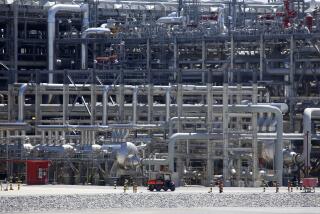Old Process, New Needs Boost Gas Technology
- Share via
Even as fears about the price and availability of energy rise and fall with the daily weather report, the twin forces of technology and environmental regulation are developing improved energy sources for the present decade and beyond.
The biggest energy companies, Exxon Mobil Corp., Royal Dutch Shell Group and Chevron Corp., are constructing or planning facilities to convert natural gas to clean liquid fuels, such as sulfur-free diesel and heating oil.
London-based Shell is considering six locations for gas-to-liquids plants--Egypt, Argentina, Iran, Trinidad and Tobago, Indonesia and Australia. The company will choose two sites and start building plants next year and will follow with two more plants later in the decade. Shell operates a gas-to-liquids plant in Bintulu, Malaysia.
Chevron is building a huge project in Nigeria that will turn natural gas from a waste product of oil production into a fuel to produce electricity for Ghana, Togo and other West African nations. A gas-to-liquids facility, to produce clean fuel for export to Europe, will be part of the Chevron project.
Exxon Mobil is considering a plant in Qatar, a small but gas-rich country on the Persian Gulf.
It’s significant that gas-to-liquids projects are planned for Egypt, Qatar, Nigeria and other countries remote from gas markets and international pipelines. The gas in such areas is now producible but “shut in,” in the oil industry’s term, because it’s not readily marketable.
And there’s a lot of shut-in gas--up to 2,500 trillion cubic feet, equal to half the world’s known gas supplies, experts say. North America has enormous unproduced gas supplies in remote places, such as Canada’s Hudson’s Bay, notes Joseph Tovey, an investment banker specializing in energy.
The mounting interest in converting such shut-in gas is driven in part by environmental restrictions on diesel fuel about to go into effect, says analyst Martin Meyers of Cambridge Energy Research Associates. The United States, Europe and Canada have instituted regulations to reduce sulfur in diesel fuel within five years. Diesel drives big trucks in the U.S. and many passenger cars in other countries. The liquid fuel that results from processing natural gas contains almost no sulfur and other pollutants.
Small companies, such as Syntroleum Corp. of Tulsa, Okla., and Rentech Inc. of Denver, have processes that work on smaller deposits of gas or eliminate other environmental problems. Also, Ivanhoe Energy Corp., a small company headquartered in Vancouver, Canada, but with major operations in Bakersfield, is involved with Syntroleum in a gas-to-liquids project in Australia.
Yet for all the sudden interest, gas-to-liquids is not a brand-new, dot-com-like invention. Rather, the processes being used today derive from one invented in 1923 by two German chemists, Franz Fischer and Hans Tropsch. That process helped Germany develop synthetic fuel oil in World War II. South Africa adapted it to produce liquid fuel from coal in recent decades, and South African company Sasol is now engaged in building a gas-to-liquids plant in Qatar.
Liquid fuel from natural gas is different from the more widely known liquefied natural gas. With LNG, gas is frozen, shipped in costly special tankers, then thawed back into gaseous form and used to heat homes or generate electricity. The cost of LNG projects is akin to that of pipelines, in the $10-billion range.
But even large gas-to-liquids plants can be built for as little as $2.5 billion, a more easily investable sum for big oil companies. The fuel produced can be sold in today’s filling stations or blended in refineries to reduce sulfur levels. With further processing, liquids from gas can be turned into gasoline, notes Barbara Shook, an analyst at the Energy Intelligence Group, a Houston research firm.
The news that there is a lot of natural gas available and that it can be produced economically is reassuring at a time when the outlook for natural gas is not so reassuring. Greatly increased exploration for natural gas this year has failed to turn up vast new supplies.
Natural gas prices may be down from the stratospheric highs of last winter, but that’s only because the world’s economies are in a slow period. Don’t be fooled by the lull, advises analyst Stuart Wagner of Petrie Parkman, a Denver energy research firm. Natural gas prices next year will be close to $4 per thousand cubic feet, Wagner predicts, more than double the price level of the last decade and more.
Clean fuels from natural gas will be one solution among many in the coming decade as environmental regulations increase here and abroad in response to greater access to cars, air conditioning and other energy-consuming aspects of modern urban living.
Also, the Bush administration’s energy plan counts on natural gas to play an increasing role in ensuring that U.S. living standards can be enjoyed without environmental breakdown.
Energy companies recognize this. That’s why Exxon Mobil, Royal Dutch Shell and Chevron are devoting parts of their $22 billion in combined annual capital investments to gas-to-liquids projects and other technologies. Fuels of the future will be different from those of the past.
James Flanigan can be reached at jim.flanigan@latimes.com.
More to Read
Sign up for Essential California
The most important California stories and recommendations in your inbox every morning.
You may occasionally receive promotional content from the Los Angeles Times.










